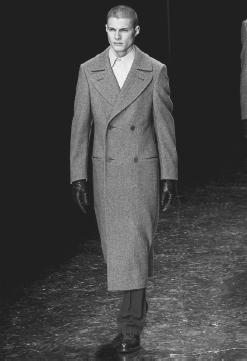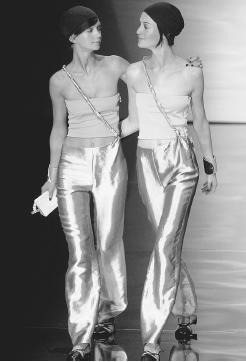Giorgio Armani - Fashion Designer Encyclopedia
Italian designer
Born: Piacenza, Italy, 11 July 1934. Education: Studied medicine, University of Bologna, 1952-53; also studied photography. Military Service: Served in the Italian Army, 1953-54. Family: Life partner, Sergio Galeotti (died 1985). Career: Window display designer, La Rinascente department stores, 1954; stylist, menswear buyer, La Rinascente stores, 1954-60; menswear designer, Nino Cerruti, 1960-70; freelance designer, 1970-75; first Armani menswear collection, 1974; introduced womenswear, 1975; launched Emporio Armani and Armani Jeans, 1981; Mani womenswear debuted, mid-1980s; Giorgio Armani Occhiali and Giorgio Armani Calze, 1987; sportswear range and Emporio Armani shops selling younger collection opened in London, 1989; Giorgio Armani USA formed, 1980; bought Antinea, 1990; AX, Armani Exchange, boutiques with lesser-priced basics opened in the U.S., 1991; acquired majority stake in Simint, 1996; bought Intai accessories producer, 1998; forged alliance with Ermenegildo Zegna, 2000; launched website, 2000; opened new Hong Kong and SoHo stores, 2001; fragrances include Armani le Parfum, 1982, Armani Eau pour Homme, 1984, and Gio, 1992; Acqua

Publications
On ARMANI:
Books
Combray, Richard de, and Arturo Carlo Quintavalle, Giorgio Armani, Milan, 1982.
Hayden Gallery, Massachusetts Institute of Technology, Intimate Architecture: Contemporary Clothing Design [exhibition catalogue], Cambridge, MA., 1982.
Barbieri, Gian Paolo, Artificial, Paris, 1982.
Alfonsi, Maria-Vittoria, Leaders in Fashion: I grandi personaggi della moda, Bologna, 1983.
Milbank, Caroline Rennolds, Couture: The Great Designers, New York, 1985.
Perschetz, Lois, ed., W, The Designing Life, New York, 1987.
Coleridge, Nicholas, The Fashion Conspiracy, London, 1988.
Howell, Georgina, Sultans of Style: 30 Years of Fashion and Passion 1960
-1990, London, 1990. Martin, Richard, and Harold Koda, Giorgio Armani: Images of Man, New York, 1990.
White, Nicola, Giorgio Armani, New York, 2000.
Celant, Germano, and Harold Koda, New York & London, 2000.
Giorgio Armani: Twenty-Five Photographers, Ostfildern, 2001.
Giorgio Armani, Fundación del Museo Guggenheim, Bilboa, 2001.
Articles
Hamilton, Rita, "Giorgio Armani's Fine Italian Hand," in Esquire (New York), 22 May 1979.
"Giorgio Armani," in Time, May 1982.
Barbieri, Giampaolo, "La moda diventa arte," in Amica (Milan), December 1982.
Teston, E., "A Visit With Giorgio Armani," in Architectural Digest, May 1983.
"Armani: Success, Tailor Made," in Vogue, August 1984.
Mower, Sarah, "Giorgio Armani: A Man for All Seasons," in Woman's Journal (London), April 1986.
Thurman, Judith, "A Cut Above," in Connoisseur (New York), August 1986.
Romanelli, Marco, "Giorgio Armani: Il progetto dell'abito 1988," in Domus (Milan), January 1988.
Brantley, Ben, "The Armani Mystique," in Vanity Fair, June 1988.
Brantley, Bill, "The Emperor of New Clothes," in the Daily Telegraph Weekend Magazine (London), 17 December 1988.
Mower, Sarah, "Emperor Armani," in Vogue (London), January 1989.
Keers, Paul, "The Emporio of Style," in GQ (London), February/March 1989.
Kostner, Kevin, "The Emporio Strikes Back," in Sky (London), March 1989.
West, Carinthia, "Giorgio Armani," in Marie Claire (London), April 1989.
Cohen, Eddie Lee, "Giorgio Armani," in Interior Design, April 1989.
Furness, Janine, "Alluring Armani," in Interior Design, May 1989.
Cohen, Eddie Lee, "Emporio Armani," in Interior Design, September 1989.
Brampton, Sally, "Armani's Island," in Elle Decoration (London), Autumn 1989.
Howell, Georgina, "Armani: The Man Who Fell to Earth," in the Sunday Times Magazine (London), 18 February 1990.
Mardore, Lucienne, "La storia di Giorgio Armani," in Marie Claire (Paris), May 1990.
Borioli, Gisella, "Giorgio Armani: This is the Real Me," in Donna (Milan), October 1990.
LaFerla, Ruth, "Sizing Up Giorgio Armani," in the New York Times Magazine, 21 October 1990.
Gerrie, Anthea, "Giorgio Armani," in Clothes Show (London), June 1991.
Friend, Ted, "The Armani Edge," in Vogue, March 1992.
Doyle, Kevin, "Armani's True Confessions," in Women's Wear Daily, 25 June 1992.
Hutton, Lauren, "Giorgio Armani," in Interview (New York), April 1993.
Forden, Sara Gay, "Numero Uno: Giorgio Armani, the World's Most Successful Designer, Still Isn't Satisfied," in Women's Wear Daily, 26 October 1994.
Schiff, Stephen, "Lunch with Mr. Armani, Tea with Mr. Versace, Dinner with Mr. Valentino," in the New Yorker, 7 November 1994.
Menkes, Suzy, "Armani's Off-the-Rack Mozart," in the International Herald Tribune, 17 January 1995.
Forden, Sara Gay, "According to Armani," in DNR, 19 January 1995.
Spindler, Amy M. "Armani and Ferré: A Study in Contrast," in the New York Times, 11 March 1995.
Moin, David, Sharon Edelson, and Samantha Conti, "The Armani Blitz Begins (Giorgio Armani Stores in New York, New York)" in Women's Wear Daily, 9 September 1996.
Rawsthorn, Alice, "Master of the Cool Classic," in the Financial Times, 25 August 1997.
Socha, Miles, "Giorgio Armani," in Women's Wear Daily, 3 April 1998.
Conti, Samantha, "Giorgio Armani: The Changing Face of Elegance," in Women's Wear Daily, 23 June 1999.
Zargani, Luisa, "Armani and Zegna Form Joint Venture," in Women's Wear Daily, 25 July 2000.
Conti, Samantha, "At Home with Giorgio Armani," in Women's Wear Daily, 14 September 2000.
Heller, Richard, "Last Man Standing (Designer Giorgio Armani)," in Forbes, 12 November 2001.
***
Giorgio Armani is a design colonialist responsible for the creation of an aesthetic in both menswear and womenswear that had a firm grip on international style in the 1980s. Renowned for his use of fabric and expertise in tailoring, he is a world leader in menswear design responsible for the wide-shouldered look for executive women. His pared-down unstructured silhouette moved away from the standard tailored look epitomizing menswear since the 19th century; by eliminating interfaces, linings, and shoulder pads, Armani restructured the jacket, creating a softly tailored look.
Although Armani produces entire ranges of these functional, adaptable, flexible items of clothing that seem almost throwaway in their simplicity, they are, in fact, luxurious designs made of high-quality cloth. His clothes, however, although expensive, have their own understated glamour and could never be described as ostentatious. Neither trend nor tradition, the Armani style draws a fine line between the two. Eschewing change for its own sake, he believes in quality rather than invention. His collections are redefinitions of a

Born in Piacenza, Italy, in 1934, Armani's first taste of the fashion industry was with La Rinascente, a large Italian department store chain where in 1954 he worked on the window displays. He then transferred to the Office of Fashion and Style where he had an invaluable training in the use of fabrics and the importance of customer profiling and targeting. After seven years he left to design menswear for Nino Cerruti, and for a month worked in one of the firm's textile factories where he learned to appreciate fabric, the skills that went into its production, and the techniques of industrial tailoring.
In 1974 Armani launched his own label, which was to become incredibly successful—the biggest-selling line of European design in America. His first designs revolved around the refining of the male jacket, which he believed to be the most important invention in the history of dress, being both versatile and functional and suited to all social occasions. His idea was to instil the relaxation of sports clothing into its tailored lines. He later applied similar notions to womenswear, evolving a new manner of dress for women. He further developed a style for working women with an understated, almost androgynous chic.
In these years, Armani designs were very expensive, being made out of the most luxurious materials such as alpaca, cashmere, and suede. To expand his customer base and meet the increasing demands of a fashion conscious public for clothes with a designer label, he produced a cheaper womenswear range entitled Mani, made out of synthetics so advanced they could not be copied, together with the popular Emporio Armani range of sportswear. For men he produced definitive navy blazers, crumpled linen jackets, and leather separates, which he introduced in 1980, and oversized overcoats and raincoats. Impeccably tailored, with faltering cut, easy lines, and subtle textures, patterns, and colors, he introduced twists such as lowslung button placement on double-breasted suits for men and experimental blends of fabrics such as viscose with wool or linen with silk.
Like his contemporaries in the industry, Armani diversified into jeans, undergarments, neckwear, golf apparel, accessories, fragrances, and more recently, cosmetics. With more than a dozen clothing lines, the quality has not diminished, merely attracted a wider clientéle which in turn attracted the notice of luxury conglomerates LVMH and Gucci Group. Both approached Armani with acquisitive offers, but he refused. "Of course, I was flattered," he told Richard Heller of Forbes (12 November 2001), "But I decided to keep my independence." He is, indeed, one of a disappearing breed, without stockholders or backers to answer to—rather, he has increasingly bought his licensees and brought most Armani brand in-house.
If ever there was a doubt about how the world felt about Armani and his contributions to fashion, they were completley dispelled in November 2000 when the Guggenheim Museum threw a lavish gala to mark the opening of its Giorgio Armani retrospective in New York. Covering 25 years of Armani creativity and featuring 400 garments, the exhibition attracted a glittering crowd including Hollywood celebrities, athletes, and musicians. Giorgio Armani, now and forever, represents the finest in elegant, sophisticated style.
—CarolineCox;
updated by NellyRhodes
Comment about this article, ask questions, or add new information about this topic: